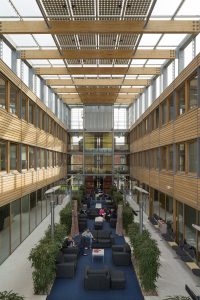
December 1, 2017, by Shirlene Campbell Ritchie
Do green-certified buildings increase occupant satisfaction? It’s complicated…
A groundbreaking study suggests that earning green certification and specific Indoor Environmental Quality (IEQ) credits do not necessarily enhance occupant satisfaction.
A study led by Professor Sergio Altomonte of the Department of Architecture and Built Environment (DABE), now at the Universite’ catholique de Louvain (UCLouvain), Belgium, and Professors Stefano Schiavon and Gail Brager, University of California Berkeley, with Dr Michael Kent of DABE, offers valuable insights into the building industry.
In particular, the study highlighted the complexities that can emerge when creating a more satisfactory interior space in terms of indoor environmental quality.
Architects, building engineers, policy makers and building owners often rely on green-certification programs such as:
- Building Research Establishment Environmental Assessment Method (BREEAM) and
- Leadership in Energy and Environmental Design (LEED) to achieve more sustainable and healthy built environments.
However, the study showed that while green certification is mostly earned upon design intent, many things can change between the design stage of a project and its operation and post-occupancy evaluation. Thus, to truly ensure that improved IEQ has been achieved, building professionals need to be involved in performance monitoring to continuously fine-tune operating strategies.
The study shed further light on whether the current metrics which go towards achieving an IEQ credit were designed to translate into improved user satisfaction as opposed to being defined merely in terms of physical metrics. For example, achieving a higher level of certification, such as Gold or Platinum, does not enhance occupants’ satisfaction with the related environmental factor which can include temperature, lighting, acoustics and so forth.
IEQ certification metrics should focus on the occupants as much as on the building, ideally considering the substantial differences – demographic, physiological, socio-cultural, etc. – that characterise building users, rather than solely responding to the needs of an average standard occupant.

Image by: Martine Hamilton-Knight
Dearing Building, Jubilee Campus, The University of Nottingham (UK) ©
Green certification criteria should also consider that satisfaction is a comprehensive design objective that is not only affected by the conventional IEQ parameters of heat, light, sound, and air quality, but is also driven by complex physiological and psychological dimensions surrounding personal health and wellbeing. A more integrative perspective is essential for simultaneously promoting enriched comfort, energy performance, and enhanced workplace experience.
The study, which has been published in the academic journal Building Research and Information, is based on commercial buildings data from the Centre for the Built Environment occupant satisfaction survey database at the University of California Berkeley.
No comments yet, fill out a comment to be the first

Leave a Reply